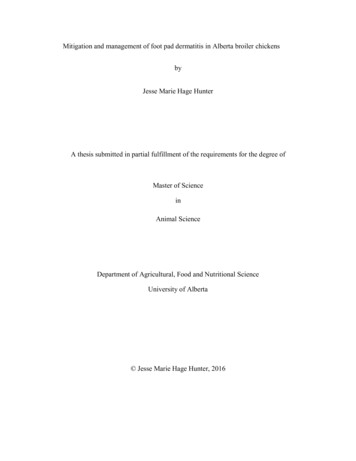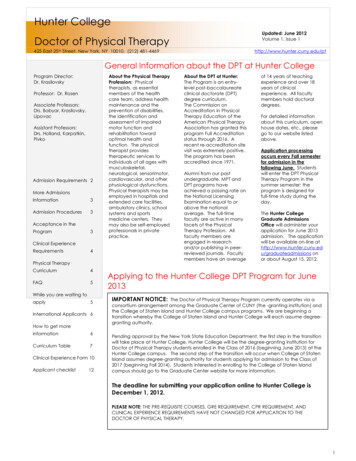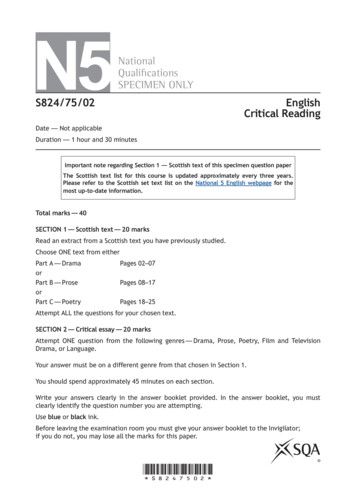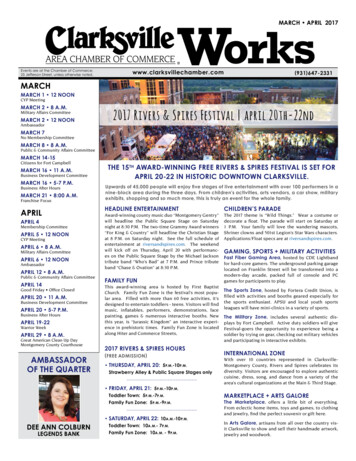
Transcription
Mitigation and management of foot pad dermatitis in Alberta broiler chickensbyJesse Marie Hage HunterA thesis submitted in partial fulfillment of the requirements for the degree ofMaster of ScienceinAnimal ScienceDepartment of Agricultural, Food and Nutritional ScienceUniversity of Alberta Jesse Marie Hage Hunter, 2016
Thesis AbstractFoot pad dermatitis was identified as a welfare concern by the Alberta broiler industry. However,there are no published studies benchmarking foot pad dermatitis or methods of foot pad assessmentrecommended to producers in Alberta. Thus, the objectives of the thesis were to benchmark footpad dermatitis on Alberta broiler flocks, investigate the correlation between three methods of footpad assessment and repeatability of the processing line assessment, identify management practicesrelated to foot pad dermatitis on-farm and assess the impact of platforms and peat moss on footpad quality. Chapter 3 found mean prevalence of foot pad dermatitis for each assessment methodwas 28.7% (on-farm), 26.2% (processor-line) and 31.8% (processor-sampled) On-farm andprocessor-sampled scores were highly correlated (r 0.90; P 0.01), while processor-line scoreswere not repeatable between measurements (P 0.01). The variability in the processor-lineinfluenced correlation scores between processor-line and processor-sampled (r 0.72, P 0.01) andon-farm (r 0.77; P 0.01). Foot pad dermatitis prevalence was greater on straw litter (40.6%)compared to other litter types (6.4%). Platform use increased with age, and had no impact on footpad quality, carcass or body weight (Chapter 4). Wheat Straw had the highest litter moisture andfoot pad scores, while Pine Shavings and Pine/Peat had the lowest litter moisture and foot padscores (P 0.01). Peat had an acidifying impact on pH in both Wheat/Peat and Pine/Peat pens, andslightly decreased litter moisture for Wheat/Peat pens. Processors are advised to revise linescoring. Producers are recommended to use pine shavings litter to reduce foot pad dermatitis andWheat/Peat to moderately improve litter quality. Platform structures were used and should beincreased in size to maximize bird benefit. Producers are strongly encouraged to assess each flockfor foot pad dermatitis using the 4-point scale, as it was shown to be accurate and feasible for useon-farm. Legislation mandating use of pine shavings on farm is recommended, but emphasisshould be placed on ensuring producers are assessing foot pad dermatitis on-farm.ii
PrefaceAll animal protocols and use were approved by the University of Alberta Animal Care and UseCommittee (Livestock) in accordance with Canadian Council for Animal Care Requirements(Protocol number: AUP 1235).Survey questions and participant consent were reviewed and approved by the REB2 HumanEthics Committee of the Research Ethics Office at the University of Alberta (Protocol number:PRO00052391).iii
DedicationFor Carl: My love, thank you for helping me through these past two years and being theconstant positive presence that I needed (even when I complained about it). Thank you forsupporting me throughout this degree. I love you, and I look forward to our out-of-school futuretogether!For my chickens: Spending time with you on-farm and during the trial was the best part of mydegree, and kept me motivated during the tough times. Thank you.iv
Acknowledgements:This research was completed with funding provided by the Alberta Livestock and Meat Agency,Agriculture and Agri-Food Canada, Agri-Innovation program (Growing Forward 2) and AlbertaChicken Producers. Additional in-kind support was provided by Alberta broiler producers, SofinaFoods, the University of Alberta and the University of Saskatchewan.Thank you to my supervisor, Dr. Clover Bench, for your support. We have had a bumpy road, butI know it is thanks to your dedication to my success that I have finished this thesis. Thank you forthe heartfelt conversations, countless discussions, and always pushing me to achieve the best Icould. Thank you for giving me this opportunity.Thank you to my committee member, Dr. Doug Korver for your dry humour, advice and patiencewith my many “quick” nutrition questions throughout the research and writing of this thesis.Further, thank you to Dr. Scott Jeffrey for taking the time to review my thesis and participate asmy external examiner.Thank you to Emmanuel Opoku Yeboah for your dedication throughout our work. I trulyappreciate the long hours, research, and hard work you contributed to this research.Thank you to all additional professors who have helped me throughout this thesis. Special thanksto Dr. Sven Anders, who helped me with my survey analysis and offered great perspective on the“big” picture of my research. Also to Dr. Martin Zuidhof for providing many poultry opportunitiesto help me learn and expand my knowledge of the poultry industry.v
Thank you to Teryn Gilmet for the support, laughter, advice and inspiration throughout thisdegree. You helped me find confidence in myself and my studies, and I am very grateful to havemet you.Thank you to the Ethology lab, past and present for your help and support. Teryn Gilmet, CaitlynErickson, Emmanuel Opoku Yeboah, Hector Perez, Mirjam Guesgen, Sarah Nowicki.Thank you to all of the poultry grad students: Kooney, Bello, Saman, Misaki, Sasha, Sheila andPaulo. Thank you for your help, advice and friendship. All the best for the future!Thank you to all of the Poultry Research Centre staff: Lyle, Giles, Shawn, Chris, Rachelle, Kerryand Amber. I cannot thank you enough for all the knowledge, help and humour you brought to thebarn during this research. I am so glad I got to work with you all.Thank you to all of the volunteers who participated to make this thesis possible. Special thanks toMatt Oryschak, who helped greatly with the design and implementation of the research trial.Thank you to all of the producers who participated in my field study. Thank you for being sowelcoming and helpful during our farm visits. Thank you to John, for your humour and endlesspatience during sample collection which allowed this thesis to be completed. I am very grateful tohave had the opportunity to work with the Alberta broiler industry.Thank you to my friends and family, who have been supportive throughout the completion of thisthesis. I could not have finished without you.vi
Table of ContentsPagesThesis ist of tablesxiList of figuresxii1.0. A review of the development and prevention of foot pad dermatitis inbroiler chickens11.1. Definition and etiology of foot pad dermatitis11.1.1. Definition11.1.2. Relationship of ammonia, water and foot pad dermatitis11.1.3. Histology of foot pad dermatitis11.2. Welfare and economic implications of foot pad dermatitis21.2.1. Welfare31.2.2. Prevalence of foot pad dermatitis31.2.3. Foot pad market41.3. Management of foot pad dermatitis through assessment1.3.1. Methods of assessment1.4. Management factors which influence foot pad dermatitis5661.4.1. Litter81.4.2. Nutrition91.4.3. Stocking density111.4.4. Barn environment131.5. Alternative prevention strategies1.5.1. Behaviour141515vii
1.6. Conclusions171.7. References172.0. Thesis objectives293.0. Practical assessment and management of foot pad dermatitis in commercialbroiler chickens313.1. Introduction313.2. Materials and methods333.2.1. Animal care333.2.2. Experimental design343.2.3. Data collection: survey353.2.4. Data collection: on-farm foot pad and litter assessment353.2.5. Data collection: processing line373.2.6. Data collection: processor foot pad samples373.2.7. Statistical analysis: survey373.2.8. Statistical analysis: foot pad litter and odour scores393.3. Results and Discussion403.3.1. Foot pad dermatitis prevalence and assessment method413.3.2. Management practices433.4. Conclusions & applications503.5. Acknowledgements513.6. References514.0. Impact of raised slatted platforms and litter material on broiler chicken footpad quality644.1. Introduction4.2. Materials and methods64674.2.1. Animals & facilities674.2.2. Experimental design674.2.3. Litter treatments68viii
4.2.4. Platform treatments684.2.5. Behaviour Observations694.2.6. Foot pad & gait assessment704.2.7. Moisture retention test and litter sampling704.2.8. Production parameter measurements714.2.9. Statistical analysis724.3. Results724.3.1. Behaviour734.3.2. Body weight, feed and carcass734.3.3. Litter moisture, pH and moisture retention754.3.4. Foot pad score754.3.5. Gait score754.4. Discussion754.4.1. Platform treatment784.4.2. Bedding treatment814.4.3. Gait scores824.5. Conclusion834.6 Acknowledgments834.7. References845.0. Synthesis1045.1. Review of thesis objectives1045.2. Prevalence of foot pad dermatitis1045.3. Assessment of foot pad dermatitis1075.4. Litter management and strategies1095.5. Additional management strategies1115.6. Recommendations113ix
5.7. Conclusions1145.8. References115References118Appendix A132Appendix B136Appendix C138Appendix D140x
List of TablesTable 3.1. Foot pad, litter and odour assessment systems57Table 3.2. Frequency of responses for selected survey questions (foot pad dermatitis,flock, water, nutrition, flock)58Table 3.3. Frequency of responses for selected survey questions (barn, litter,lighting)59Table 3.4. Statistical results from t-test and ANOVA on selected survey questions60Table 3.5. Distribution of foot pad scores by severity for each producer61Table 4.1. Ethogram of mutually-exclusive behaviours observed during scansampling of broiler chickens91Table 4.2. Scoring systems for foot pad and gait assessment in broiler chickens92Table 4.3. Lsmeans for all observed behaviours for platform treatment93Table 4.4. Lsmeans for all observed behaviours for litter treatments94Table 4.5. Effect of age on behaviour95Table 4.6. Production parameters measured (BW, ADG, ADFI, FCR)96Table 4.7. Lsmeans of carcass components (g)97Table 4.8. Lsmeans of yield of carcass components (%)98Table 4.9. Moisture absorbed, released, final moisture content of clean, unusedbedding materials tested.99Table 4.10. Litter and foot pad scores100xi
List of FiguresFigure 1.1. Conversion of uric acid to ammonia after fecal excretion by broilerchicken28Figure 3.1. Correlation matrix for foot pad assessment methods62Figure 3.2. Least square mean foot pad scores for on-farm, processor-line andprocessor-sampled methods by producer634.1. Photograph of raised, slatted platform101Figure 4.2. Pen diagram used in study102Figure 4.3. Lsmeans of gait score by treatment103xii
1.0. A review of the development and prevention of foot pad dermatitis in broiler chickens1.1. Definition and etiology of foot pad dermatitis1.1.1. DefinitionFoot pad dermatitis is a skin condition in broiler chickens characterized by lesions thatdevelop on the underside of the foot which develop as early as 7 days of age (Mayne, 2005;Hashimoto et al., 2011). Lesions range from minor skin irritation to severe ulcerations which cancover the entire underside of the foot (both foot pad and toes; Ventura et al., 2010). Foot paddermatitis in broilers is associated with necrosis of the foot pad, which presents itself as a crustylesion (Michel et al., 2012). Foot pad dermatitis is distinct from other dermatitis conditionsobserved in poultry, such as bumblefoot observed in laying hens. Bumblefoot is characterized bya spherical inflammation as a result of infection, which occurs around the entirety of the foot(Struelens and Tuyttens, 2009). Broiler foot pad dermatitis is not caused by an infection, butoccurs after the foot pad has prolonged contact with an irritant in the environment (e.g.moisture), resulting in skin degradation (Sirri et al., 2007). Foot pad dermatitis was considered acontact dermatitis after examination of microbial and fungal communities on both healthy andlesioned foot pads (Martland, 1985). Neither microbial or fungal communities were significantlydifferent, suggesting that neither bacteria nor fungi were the underlying cause of foot paddermatitis and lesions must result from some other factor (Greene et al., 1985; Martland, 1985).1.1.2. Relationship of ammonia, water and foot pad dermatitisPrevious research theorized foot pad lesions were due to excess ammonia in the litter(Ekstrand et al., 1997; Haslam et al., 2006). Ammonia is produced from the degradation of fecaluric acid through the interaction of microbes, water and oxygen in the litter (Figure 1.1). Poor1
litter conditions are often associated with a high concentration of ammonia, as well as severe footpad dermatitis. As such, excess ammonia became associated with the development of foot pad“ammonia burns” (Kyvsgaard et al., 2013). However, the production of ammonia cannot takeplace without litter moisture levels of 33%, after which the degradation of uric acid and ureacan occur (Figure 1.1; Nahm, 2003; Dunlop et al., 2015).Litter moisture is accumulated through multiple sources. For example, condensation fromheat generation by broilers and barn heating system result in increased litter moisture. Othersources of litter moisture include water during fecal excretion, and leakage from the drinkersystem in a barn. Constant contact of the foot pad with accumulated litter moisture results insoftening and irritation of the skin, which makes the foot pad more susceptible to lesiondevelopment (Mayne, 2005). Additionally, wet litter increases the likelihood of fecal and litterdebris sticking to the foot pad. Thus, excess litter moisture is currently the leading theoreticalcause of foot pad dermatitis (de Jong et al., 2014).1.1.3. Histology of foot pad dermatitisThe skin which covers the foot pad acts as a protective layer against disease, infectionand water loss (Barbut, 2015). Chicken skin is composed of the epidermis (outer layer) and thedermis (inner layer; Barbut, 2015). Keratin cells (keratinocytes) are produced in the dermis andare composed of stiff protein fibres within a cornified matrix (van Hemert et al., 2012; Lees etal., 2014). Keratin is metabolically inactive and resilient to environmental stressors whichprovides protection and structural support for the skin (Dhouailly, 2009). The epidermis iscomposed primarily of keratin which is concentrated in the hardened, hydrophobic outer layercalled the stratum corneum (Grist, 2006; Lawrence et al., 2012). Irritation of the stratum2
corneum is the first stage of foot pad dermatitis, resulting in red discolouration of the skin(Ekstrand et al., 1997). Lesion severity increases after prolonged contact between the stratumcorneum and water, which prompts migration of heterophilic inflammatory cells from the dermis(Martland, 1985; Greene et al., 1985). Prolonged contact with litter moisture irritates the skin andcauses increased numbers of inflammatory cells to migrate to the epidermis. The resultinginflammation forces the stratum corneum to pull apart, reducing the protective keratin layer andexposing the remaining epidermis and dermis to the litter (Greene et al., 1985; Martland, 1985).At this stage, the lesion is now brown/black in colour, but small (1-3mm). As the stratumcorneum is forced further apart, blood vessels within the foot pad become constricted fromsurrounding inflammation (Martland, 1984). Loss of blood flow results in necrosis of theepidermis and the brown/black lesion increases to 5-7 mm in diameter (Greene et al., 1985). Thefinal stage is characterized by necrosis of the skin on either toes and/or foot pad, and severeinflammation of the dermis (Ekstrand et al., 1998). Lesions at this stage tend to collect fecalmicroorganisms, as well as litter debris and are 7-12 mm in diameter (Greene et al., 1985).1.2. Welfare and economic implications of foot pad dermatitis1.2.1. WelfareThe World Organization for Animal Health (2016) defines animal welfare as the state ofan animal as it attempts to cope with its environment. A good welfare state is defined as theability to express natural behaviours and maintain health in a comfortable environment, and theabsence of pain or discomfort. Broilers affected by foot pad dermatitis are considered to be in anegative welfare state (Bessei, 2006). Presence of foot pad lesions indicates broilers are havingdifficulty coping with environmental conditions within the barn, and may be experiencing pain3
caused by inflamed lesions (Haslam et al., 2006; Buijs et al., 2009; de Jong et al., 2014). Footpad lesions are associated with tissue damage and inflammation, which can stimulate painreceptors during foot pad lesion development (Haslam et al., 2006; Loeser and Treede, 2008;Gentle, 2011; de Jong et al., 2014). Further evidence to support claims that foot pad dermatitis ispainful has come from studies researching dietary preference tests. When broilers are given thechoice between food containing analgesic and food without analgesic, broilers affected by footpad dermatitis were reported to consistently choose the food with analgesic. Further, afterconsuming food with analgesic, broilers then exhibited improved walking ability (Weeks et al.,2000; Danbury et al., 2000). Thus, foot pad dermatitis is considered a painful condition forbroilers and has been deemed a welfare concern.1.2.2. Prevalence of foot pad dermatitisAlthough globally recognized as a welfare issue in broilers, the prevalence of foot paddermatitis is unavailable for many broiler producing countries (e.g. Brazil, Canada, UnitedStates). In Japan, prevalence was assessed over 45 commercial flocks and was 31.8% to 100%(Hashimoto et al., 2011). In Sweden, average prevalence of foot pad dermatitis was measured on23 flocks and was reported as 34.7%, but ranged from 2% to 82% among flocks (Ekstrand et al.,1997). In the United Kingdom, mean foot pad dermatitis prevalence over 190 flocks was foundto be 18.1% (Pagazaurtundua and Warriss, 2006a). However, the range reported for the UnitedKingdom was also large, with 6.3% of flocks reporting no foot pad lesions, and one flock with92% lesion prevalence (Pagazaurtundua and Warriss, 2006a). In Portugal, mean prevalence offoot pad dermatitis measured on 765,000 broilers was 74.8% (Gouveia et al., 2009). In France,foot pad dermatitis across 55 flocks was measured at 70% (Allain et al., 2009). Finally, foot paddermatitis was estimated at 38.4% across 386 broiler flocks in the Netherlands (de Jong et al.,4
2012). The diversity in range and prevalence between these estimates could be due to thedifferences in flocks assessed, flock size, or characteristics of the flock. For example, prevalenceof foot pad dermatitis in Portugal (74.8%) was larger than the United Kingdom (18.1%).However, broilers in Portuguese flocks were slaughtered at 70-100 days of age, compared to 42days of age in the United Kingdom (Pagazaurtundua and Warriss, 2006a). Broilers raised toolder ages will be kept on the same litter for longer will have prolonged contact with littermaterial, and thus more time to develop foot pad dermatitis. Another source of variabilitybetween estimates could be the diversity in the size of foot pad assessment scales used for eachstudy. Foot pad dermatitis was assessed using a 3-point scale in Portugal and the Netherlands, a4-point scale in Japan and the United Kingdom, a 6-point scale in Sweden, and a 9-point scale inFrance which makes it difficult to compare assessments. Another factor which has been reportedto affect prevalence of foot pad dermatitis is the type of broiler housing systems. For example, inthe United Kingdom, conventional commercial systems (indoor free-run) recorded 14.8%prevalence, while free-range and free-range organic systems (outdoor access) reported 32.8%and 98.1%, respectively (Pagazaurtundua and Warriss, 2006b). The authors speculated that thedifferences observed between systems due to age at sampling, which ranged between 39 days ofage (commercial systems), 56 days of age (free-range) and 70 days of age (free-range organic).Thus, prevalence estimates of foot pad dermatitis can vary between both housing systems andcountries depending on age at sampling, method of assessment and number of flocks assessed.1.2.3. Chicken feet marketChicken feet have been reported as the third most valuable portion of the broiler carcassas a result of increased demand from Asian markets (Shepherd and Fairchild, 2010; de Jong etal., 2011). In 2015, 683 million broilers were produced in Canada, while 63.7 million broilers5
were produced in Alberta. Chicken feet are not a major export for Canada, however there arepotentially 1.37 billion foot pads (683 million birds*2 foot pads/bird) in Canada and 127 millionfoot pads (63.7 million birds*2 foot pads/bird) in Alberta (Statistics Canada, 2015) available tobe sold. Chicken feet are estimated to be worth 0.04 (CAD)/foot for export to Asian markets(Delmar Group International, 2014), and thus total export market for chicken feet can beestimated at 54.6 million (CAD) in Canada, and 5.1 million (CAD) in Alberta if no foot padswere affected by foot pad dermatitis. Comparably however, production of breast meat is still amuch greater market, worth 406 million in Alberta and 3.9 billion in Canada in 2015(Agriculture and Agri-Food Canada, 2015). However, other countries, such as the United States,with greater poultry production reported the export of chicken feet were worth an estimated 441million in the United States in 2013, with the majority of chicken feet shipped to China andHong Kong (United States Department of Agriculture, 2013). China imported a total of 511,000metric tonnes of chicken feet in 2013 (from all countries; (United States Department ofAgriculture, 2013), which represent the majority (61.76%) of all Chinese poultry imports (asreviewed by Carvalho et al., 2014). Smaller poultry suppliers such as Argentina shippedapproximately 50,000 metric tonnes of broiler foot pads in 2007 (Guerrero-Legarreta, 2010).However, only blemish-free foot pads are exported, as blemished foot pads are deemed unfit forhuman consumption and cannot be sold. Thus, foot pad dermatitis is not only a welfare issue, butrepresents a considerable lost economic opportunity for processors (Pagazaurtundua and Warriss,2006a). Reducing the prevalence of foot pad dermatitis requires assessment and managementduring broiler production, however this does not occur in all countries.1.3. Management of foot pad dermatitis through assessment1.3.1. Methods of assessment6
The European Union Welfare Quality Assessment Protocol (Welfare Quality , 2009),the Glasgow Foot Pad Score (DEFRA, 2010), and the “Swedish” scoring method (Algers andBerg, 2001) are all on-farm, live-bird measurements used by researchers and industry to assessfoot pad dermatitis. Each scale ranges in length, from 2-point (Glasgow; DEFRA ScienceResearch & Development, 2010), 3-point (Swedish; Algers and Berg, 2001) to 5-point (WelfareQuality , 2009). On-farm foot pad assessment systems allow producers to assess each flockindividually and help mitigate foot pad dermatitis through responsive management practices.Standardized assessment systems ensure that all members of the broiler industry (producers,processors, researchers) are familiar with how foot pad dermatitis is being reported, whichfacilitates knowledge transfer regarding foot pad management techniques. However, while thesesystems are used in other countries for foot pad assessment, there is currently no standardizedsystem in Canada for foot pad scoring. Further, standardization does not guarantee that a scoringmethod will be feasible, accurate and/or reliable for producers to implement.The number of points in a scale can affect feasibility, reliability and accuracy of foot padlesion measurement. Foot pad assessment scales containing more points ( 5 points) aregenerally more accurate compared to scales with fewer points, as more points allow greaterdifferentiation between many different degrees of foot pad lesion severity. Scales with morepoints are often used for investigating the development of foot pad dermatitis, where informationregarding lesion severity is required, rather than just the presence of a lesion (Kjaer et al., 2006).However, scales with many points may be too time-consuming for use on-farm as distinguishingbetween the small differences in lesion categories can be difficult due to dim barn lighting, dustor dirty foot pads. Scales with fewer points provide sufficient information for producers ( 5points) while allowing for faster scoring and differentiation between categories. Further, scales7
with fewer points typically allow for greater inter-observer reliability between assessors andconsistent scoring of flocks. Foot pad assessment on the processing line is theoretically the mostfeasible method of scoring, as a large proportion of a flock can be scored in a short amount oftime. However, the reliability and accuracy of scores on the processing line is unknown, asassessment methods used at processing plants are not available in the scientific literature.Further, assessment at only the processing plant does not allow mitigation of foot pad dermatitiswithin a flock prior to processing, while on-farm assessment allows monitoring and managementof foot pad dermatitis throughout the production cycle. As such, theoretically on-farmassessment is a feasible and reliable method for industry to adopt. The benefits of on-farm scaleswith minimal points (2-4 points) include greater feasibility, reduced time required for scoring,and improved reliability between assessors. The consequences of using a scale with fewer pointsare decreased accuracy for assessment of lesion severity, but producers may not require the detailthat a scale with more points would provide.As technology develops, the future of foot pad assessment at the processing plant may becompletely automated. A prototype automated foot pad scoring system for use in processingplants has been investigated (Vanderhasselt et al., 2013). The automated scoring systemcompares the discolouration from the lesion to the size of the foot pad to estimate severity basedon a predefined system. Benefits of an automated system are the ability to score largeproportions of a flock and reduce assessment bias during foot pad assessment. However, theprototype still requires further testing, as the most recent report found that the prototype assessedonly 43.7% of foot pads scanned and falsely identified dermatitis on 49.4% of foot pads(Vanderhasselt et al., 2013).1.4. Management factors which influence foot pad dermatitis8
1.4.1. LitterLitter substrates used in broiler production should absorb moisture (e.g. from feces,condensation and humidity) but also allow moisture evaporation, allowing litter to dry whichhelps prevent development of foot pad dermatitis (Garcia et al., 2012). The ability to absorb andrelease moisture (absorptive or release capacity) is unique to each litter material, thus influencingmoisture content (Grimes et al., 2002; Bilgili et al., 2009). The predominant litter material usedin Canada is unknown, however the most common bedding materials used in the United Statesinclude pine shavings/chips and chopped straw (Bilgili et al., 1999; Everett et al., 2013). Pineshavings are readily available in some parts of North America and have been considered abenchmark material for comparison between foot pad dermatitis measurements as the majority offoot pad dermatitis studies take place on pine shavings bedding (as reviewed by Grimes et al.,2002 and Bilgili et al., 2009). In Alberta, pine shavings are used by the oil industry and thus pineshavings are not always readily available for producers to use. The volume of pine shavingsnecessary for broilers will change depending on the size of the barn. However, the cost forbedding a 5400 ft3 barn at a litter depth of 3 inches with pine shavings is estimated at 3200CAD, without shipping costs (Mistaya Land & Water Corp, 2014). A cheaper alternative to pineshavings is wheat straw (Stojčić et al., 2016). Bedding costs for wheat straw bedding in the same5400 ft3 barn and litter depth are estimated at 1406 CAD, including shipping (AlbertaAgriculture & Forestry, 2016). However, shipping is not usually required as many producersgrow wheat on-farm, and can use the straw by-product for broiler bedding. However, wheatstraw has a higher initial moisture content (12.2%) and retains more moisture (80.6%) comparedto pine shavings (initial moisture: 11.3%, retention: 71.2%; Bilgili et al., 2009). Greater moisturecontent and retention within straw can result in foot pads being exposed to wet litter which9
promotes foot pad dermatitis. For example, Bilgili et al. (2009) found the prevalence of foot paddermatitis was 31% on pine shavings, compared to 50% reported for chopped wheat straw. Otherlitter materials have been investigated as alternatives to pine shavings and wheat straw todetermine if they have improved litter properties or price.Sphagnum peat moss has been used as a litter material for broiler production previously(Kyvsgaard et al., 2013). Peat has a high absorption capacity, able to absorb twenty times itsweight in moisture (Everett et al., 2013) and is naturally acidic with a pH of 4.5 (Peat MossAssociation of Canada, 2016). Microbes function optimally at pH 7, and thus acidic litter helpsminimize microbial activity and ammonia production, while maintaining litter quality andreducing irritation of the foot pad (Rothrock et al., 2008; Dunlop et al., 2015). Peat wasinvestigated to determine impact on foot pad lesions in Denmark from 2004 to 2008 (Kyvsgaardet al., 2013). Broiler producers phased out the use of wheat straw, replacing bedding withsphagnum peat and/or pine shavings which resulted in a reduction of 80% to 40% in mean flockfoot pad dermatitis (Kyvsgaard et al., 2013). However, litter composed solely of peat moss tendsto become very dry, causing dust issues for both birds and farm workers (as reviewed by Ever
Agriculture and Agri-Food Canada, Agri-Innovation program (Growing Forward 2) and Alberta Chicken Producers. Additional in-kind support was provided by Alberta broiler producers, Sofina Foods, the University of Alberta and the University of Saskatchewan. Thank you to my supervisor, Dr. Clover Bench, for your support. We have had a bumpy road, but










